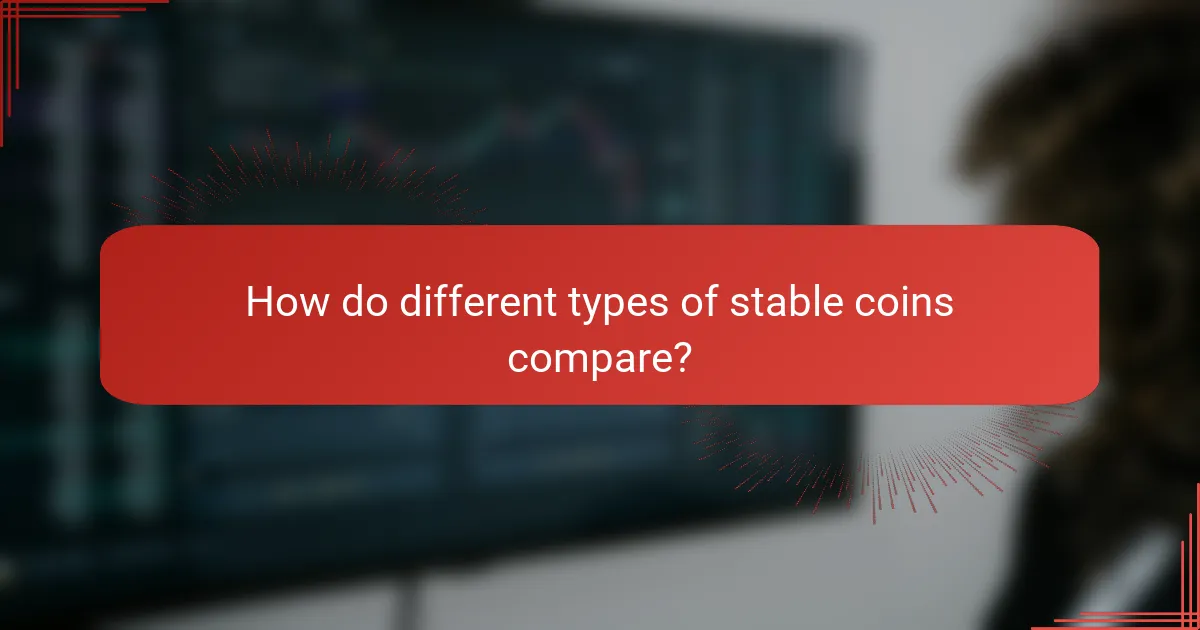Stable coins are poised for significant growth in the US market, driven by regulatory clarity and increased adoption by financial institutions. By [censured] their value to stable assets, they mitigate the volatility commonly associated with cryptocurrencies, enhancing their usability within the financial ecosystem. As advancements in blockchain technology continue and market dynamics evolve, stable coins are expected to play an increasingly integral role in both traditional finance and decentralized finance (DeFi) platforms.

What are the future predictions for stable coins in the US market?
Future predictions for stable coins in the US market indicate significant growth driven by regulatory clarity, increased adoption by financial institutions, and integration with decentralized finance (DeFi) platforms. These factors are expected to enhance the stability and usability of stable coins, making them a more integral part of the financial ecosystem.
Increased regulatory clarity
In the US, the future of stable coins hinges on clearer regulations that define their use and governance. Regulatory bodies like the SEC and CFTC are working to establish frameworks that ensure consumer protection while fostering innovation. This clarity can help mitigate risks associated with volatility and fraud, making stable coins more appealing to users.
As regulations evolve, stable coins may be categorized similarly to traditional currencies or securities, impacting how they are issued and traded. Companies that comply with these regulations could gain a competitive edge, attracting more users and investors.
Adoption by major financial institutions
Major financial institutions are increasingly recognizing the potential of stable coins, which could drive their mainstream adoption. Banks and payment processors are exploring partnerships with stable coin issuers to facilitate faster and cheaper transactions. This trend could lead to a more integrated financial system where stable coins serve as a bridge between traditional and digital currencies.
For instance, some banks are already offering services that allow customers to hold and transact in stable coins, enhancing liquidity and accessibility. As more institutions adopt these digital assets, consumer confidence is likely to grow, further propelling their use.
Integration with DeFi platforms
The integration of stable coins with DeFi platforms is set to revolutionize the financial landscape. Stable coins provide a stable medium for transactions within DeFi ecosystems, allowing users to lend, borrow, and trade without the volatility typically associated with cryptocurrencies. This functionality can attract a broader audience to DeFi services.
Moreover, as DeFi platforms continue to innovate, they may offer unique opportunities for stable coin holders, such as yield farming and liquidity mining. Users should remain aware of the risks involved, including smart contract vulnerabilities and market fluctuations, while exploring these new financial avenues.

How do stable coins impact cryptocurrency volatility?
Stable coins significantly reduce cryptocurrency volatility by [censured] their value to stable assets, such as fiat currencies or commodities. This [censured] mechanism helps maintain a consistent value, making stable coins less susceptible to the wild price swings often seen in traditional cryptocurrencies.
Stabilization of prices
Stable coins help stabilize prices in the cryptocurrency market by providing a reliable medium of exchange. When traders use stable coins, they can avoid the drastic fluctuations of other cryptocurrencies, allowing for more predictable transactions. For example, if a trader wishes to exit a volatile asset, converting to a stable coin can lock in value without the risk of immediate loss.
This stabilization is particularly beneficial during market downturns, as it allows investors to hold their assets in a less volatile form, reducing panic selling and contributing to overall market stability.
Reduced speculative trading
The presence of stable coins in the market can lead to reduced speculative trading, as they encourage more rational investment behaviors. Traders can use stable coins to hedge against volatility, which diminishes the allure of risky, speculative trades that often drive price swings. By providing a stable alternative, traders can focus on long-term strategies rather than short-term gains.
Additionally, stable coins facilitate easier access to liquidity, allowing investors to enter and exit positions without the fear of losing value during rapid market changes. This can create a more stable trading environment, fostering confidence among participants.

What are the key market dynamics influencing stable coins?
The market dynamics influencing stable coins include supply and demand fluctuations and advancements in blockchain technology. These factors play a crucial role in determining the stability, adoption, and regulatory landscape of stable coins.
Supply and demand fluctuations
Supply and demand fluctuations directly affect the value and stability of stable coins. When demand for a stable coin increases, issuers may need to mint more coins to maintain its peg to a fiat currency, such as the USD or EUR. Conversely, if demand decreases, the value can drop, leading to potential instability.
Market participants should monitor trading volumes and market sentiment to gauge demand. For instance, during periods of high volatility in traditional markets, demand for stable coins often rises as investors seek to preserve value. Understanding these trends can help investors make informed decisions about when to buy or sell stable coins.
Technological advancements in blockchain
Technological advancements in blockchain significantly impact the functionality and adoption of stable coins. Innovations such as improved consensus mechanisms and interoperability between different blockchain networks can enhance transaction speeds and reduce costs. These improvements make stable coins more appealing for everyday transactions.
Investors and users should consider the underlying technology of stable coins, as it can influence their security and efficiency. For example, stable coins built on Ethereum may benefit from its robust ecosystem, while those on newer blockchains might offer unique features. Staying informed about technological developments can provide a competitive edge in the stable coin market.

What criteria should investors consider when choosing stable coins?
Investors should consider several key criteria when selecting stable coins, including the backing assets and reserves, regulatory compliance status, and market liquidity. These factors can significantly impact the stability, safety, and usability of the stable coin in various market conditions.
Backing assets and reserves
The backing assets and reserves of a stable coin are crucial for its value stability. Most stable coins are pegged to fiat currencies like the US dollar, and their value is maintained through reserves of those currencies or other assets. For example, a stable coin might be backed 1:1 by USD held in a bank account, while others may use a mix of cryptocurrencies or commodities.
When evaluating a stable coin, check the transparency and audit reports of its reserves. A reputable stable coin should provide regular updates and third-party audits to confirm that it holds sufficient assets to back its issued coins. This can help mitigate risks associated with potential insolvency.
Regulatory compliance status
Regulatory compliance is increasingly important for stable coins, as governments around the world are developing frameworks to govern their use. A stable coin that adheres to regulations is likely to be more secure and accepted by mainstream financial institutions. Look for stable coins that comply with local laws, such as those set by the Financial Action Task Force (FATF) or other regulatory bodies.
Investors should be cautious of stable coins that operate in a regulatory gray area, as they may face legal challenges that could affect their value or usability. Staying informed about the regulatory landscape can help investors choose stable coins that are more likely to thrive in the long term.
Market liquidity
Market liquidity refers to how easily a stable coin can be bought or sold without significantly affecting its price. High liquidity is essential for investors who may want to enter or exit positions quickly. Stable coins with higher trading volumes on reputable exchanges tend to offer better liquidity.
To assess liquidity, consider the trading volume and the number of exchanges where the stable coin is listed. A stable coin that is widely traded and has a strong market presence is generally a safer choice for investors looking for stability and ease of transactions.

How do different types of stable coins compare?
Different types of stable coins serve various purposes and have distinct mechanisms for maintaining their value. Understanding the differences between fiat-backed, crypto-backed, and algorithmic stable coins is essential for making informed investment decisions.
Fiat-backed vs. crypto-backed
Fiat-backed stable coins are pegged to traditional currencies like the US dollar or euro, ensuring that each coin is backed by a corresponding amount of fiat currency held in reserve. Examples include Tether (USDT) and USD Coin (USDC), which are generally considered stable due to their direct link to government-issued money.
In contrast, crypto-backed stable coins are secured by other cryptocurrencies, often held in smart contracts. These coins, such as DAI, can be more volatile than fiat-backed options, as their value depends on the market performance of the underlying crypto assets. Users must consider the risks associated with collateralization and potential liquidation events.
Algorithmic stable coins
Algorithmic stable coins use smart contracts and algorithms to control supply and demand, aiming to maintain a stable value without direct backing by fiat or crypto assets. They adjust their supply automatically based on price fluctuations, which can create a more dynamic but potentially less predictable value stabilization.
Examples of algorithmic stable coins include TerraUSD (UST) and Ampleforth (AMPL). While these coins can offer innovative solutions, they also carry risks, such as susceptibility to market manipulation or sudden loss of peg. Investors should be cautious and thoroughly research the mechanisms behind these coins before engaging with them.

What are the risks associated with stable coins?
Stable coins carry several risks that can impact their value and usability. These include regulatory uncertainties, counterparty risks, and market volatility, all of which can affect user confidence and adoption.
Regulatory risks
Regulatory risks involve the potential for government actions that could affect the legality or operation of stable coins. As governments around the world develop frameworks for digital currencies, stable coins may face increased scrutiny or outright bans, particularly if they are seen as a threat to traditional financial systems.
For example, in the European Union, the Markets in Crypto-Assets (MiCA) regulation aims to provide a comprehensive regulatory framework for crypto assets, including stable coins. Companies operating in this space must stay informed about evolving regulations to avoid compliance issues.
Counterparty risks
Counterparty risks arise from the reliance on entities that issue or back stable coins. If the issuer fails to maintain adequate reserves or mismanages assets, the value of the stable coin can be jeopardized. This is particularly concerning for algorithmic stable coins, which depend on complex mechanisms to maintain their peg.
Users should assess the transparency and credibility of the issuing organization. For instance, stable coins backed by fiat currencies should ideally be audited regularly to ensure that reserves match the circulating supply. Lack of transparency can lead to significant trust issues and potential losses for holders.


